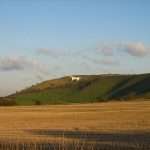Twenty-one degrees at 10 pm on the road eastward from Roscrea. The borders of Munster and Leinster at last transformed into summer lands by radically changed weather. It was hard to imagine that on the corresponding weekend two years ago this was still one of the main arterial routes of the country; that the Friday evening traffic would have been constant. Now, hardly another vehicle disturbs the twilight reverie.
Passing Ballaghmore, two horses graze in a meadow to the left: one dark, the other white. Of course, white horses aren’t called white, are they? They are greys. Except this one wasn’t, it was brilliant white against the lush green of the field. Perhaps there was something in the evening light, the horse seemed almost to glow.
White horses are mythical creatures, recorded by great chalk carvings on English hillsides. Riding the train eastward from Taunton to Paddington, there is the great white horse at Westbury; its presence coming as a surprise, no matter how frequently the journey was made.
The white horse symbolised a London-bound journey, a move from the secure and the safe and the predictable to a world of uncertainty where anything might happen and where familiar rules were inapplicable.
Far removed from those days, familiar with worlds which cast London as a place of safeness and predictability, it is odd that a white horse should still be evocative. The journey through Westbury would now seem as domestic as a drive to the supermarket, no longer would there be anything remotely threatening in that journey east.
What is there in a white horse in a Co Laois field that could prompt a mood of introspection?
Perhaps deep in the psyche there was a desire that it might be something mystical; something a startling as the great white horses seen for the first time. Perhaps the years since those Paddington journeys have thinned experiences to the extent that nothing and nowhere has now the capacity to startle.
Words of Tom Stoppard come to mind. For his character, Guildernstern, a creature sighted by two different people is as alarming as it gets, after that nothing is startling.
‘A man breaking his journey between one place and another at a third place of no name, character, population or significance, sees a unicorn cross his path and disappear. That in itself is startling, but there are precedents for mystical encounters of various kinds, or to be less extreme, a choice of persuasions to put it down to fancy; until – “My God,” says the second man, “I must be dreaming, I thought I saw a unicorn.” At which point, a dimension is added that makes the experience as alarming it will ever be. A third witness, you understand, adds no further dimension but only spreads it thinner, and a fourth thinner still, and the more witnesses there are, the thinner it gets and the more reasonable it becomes until it is as thin as reality, the name we give to the common experience… “Look, look” recites the crowd. “A horse with an arrow in its forehead! It must have been mistaken for a deer.’
A horse with an arrow in its forehead, not a unicorn. In the evening light, a grey, not a white horse.
